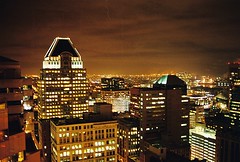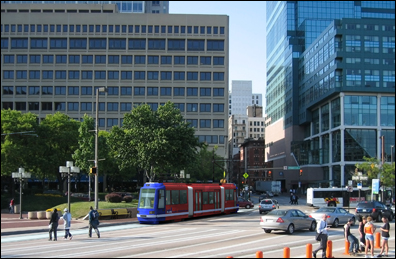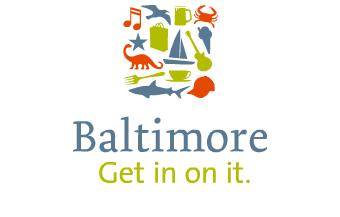Best Reason to Leave Baltimore: Bad Public Transportation-- so says the Baltimore City Paper
 A ghost from the Baltimore Streetcar Museum on Falls Road. Flickr photo by Baltimike.
A ghost from the Baltimore Streetcar Museum on Falls Road. Flickr photo by Baltimike.----------------
Guest writer: Gerry Neily (with a couple of edits). This item originally appeared in the EnvisionBaltimore googlegroup.
----------------
In last week's big annual "Best of Baltimore" issue, City Paper gives its award for Best Reason to Leave Here to "Bad Public Transportation." City Paper sums it up by saying that without a decent transit system, "we'll always be a second-class city." From the City Paper piece:
Wherever urban planner Robert Moses is now, he's probably chortling with glee over how completely our city's soul is sold to the automobile. Yes, there are buses, and light rail, and subway, but no public transport system, no web that seamlessly whisks people hither and yon efficiently, and reasonably inexpensively. If you're well-off enough to own an automobile, you grit your teeth and deal with it. But if you're not, you're beholden to taxis, hacks, buses, bikes, and walking, all with varying degrees of reliability and safety. And it's not just inconvenient--if you're poor and depend on bad public transportation, you can't get to the jobs that pay enough to buy a car, which means you still depend on crappy public transportation--lather, rinse, repeat. Washington has a great public transportation system. And despite the worst efforts of Moses, who preferred highways to public transportation, New York has one, too. Until we get ours, we'll always be a second-class city.
Yes, the transit problem really has reached such acute proportions, but it is difficult to maintain the urgency necessary to focus on solving it. The shouting on this listserve has been reduced to a whimper. It will take a huge concerted effort to get our transit system moving. The MTA has failed to do it. The City hasn't even tried. The public has been reduced to a million tiny voices shouting in the wilderness.
It will take big, bold action. The current Red Line planning process is not it - a strange assortment of alternatives that are too lame, too expensive, and mostly both. Where do we go from here?
 Baltimore at night. Photo from the MTA website.
Baltimore at night. Photo from the MTA website.1. Bus improvements have not been enough. The State's recent bus route restructuring effort has been a commendable attempt to instill some rationality into the system, but it is far too incremental to satisfy our needs. The new #40 line was the biggest change, but not nearly big enough. It appears from our experience that only a rail transit line plan has the magnetism - the gravitas - to pull together the disparate forces and elements that can translate to BOLD ACTION.
2. A streetcar project (rail or even bus) could fulfill the need for bold action if it was so consummately attractive that it utterly transformed people's hearts and minds regarding the area that it went though. Supposedly, Portland's streetcar line has done just that (if you believe the hype), but Baltimore is a much different City and a neo-streetcar system in Baltimore would need to meet Baltimore's needs and conditions, not Portland's. If not, a streetcar line would be too touristy cutesy (like Tampa's) and/or too insufficient (like Philly's new Girard Avenue line) to make the required impact.
 (Charles Street Streetcar Project photo.)
(Charles Street Streetcar Project photo.)3. A true regional rail transit project holds the most promise simply because it could draw upon the most comparable positive experiences with other cities. (This is the link for a proposed Baltimore regional rail plan. Most Baltimore area transit advocates consider the plan to be inadequate. In any case, it is being ignored for the most part.)
4. True regional rail provides the most apparent tool to achieve true maximum positive impact on the transit system. However, the planning processes for most major transportation projects are geared for minimizing impacts. The people who live in the affected areas want to go about their lives with the minimum intrusion. This may sometimes work for highways, but with transit, it is far too easy to end up with some lame project that at best is barely worth building.
5. So maximum impact is the key. Regional rail needs to utterly transform the area that it goes through, either by drawing a totally new citizenry whose lives are wrapped around the new transit lifestyle, or by achieving such breadth of impact that the transit system for a wide swath of the City becomes naturally reorganized around the rail transit system. This can be done by
(a) designing the transit line for the widest possible service corridor,
(b) making service so good and fast that the widest and largest possible service area is attracted to it,
(c) organizing the system around effective transit hubs that establish a true logical hierarchical system structure, and
(d) effectively tying the new rail line together with the existing Metro, light rail and MARC lines to create what has commonly been referred to as a "seamless system".
What we need is a Red Line Plan that, in a single swoop, generates the critical mass and energy to reorganize Baltimore's transit system into something that can achieve the required greatness.
The MTA Red Line plans do not do this. I commend the CAC/Transit Riders Action Coalition of Baltimore proposal which certainly does do it. I have tried to contribute many other options for achieving what is necessary, as I believe it can be done in a cost effective manner with either heavy or light rail, with service to existing riders as well as new development, and with various ways of using the Red Line as a catalyst to transform the existing system (Metro, light rail, MARC and buses) into something that truly works.
As City Paper says, the alternative is a second-class city.
 Baltimore brand identity campaign logo.
Baltimore brand identity campaign logo.Index Keywords: mobility; transit; urban-design-placemaking



0 Comments:
Post a Comment
<< Home